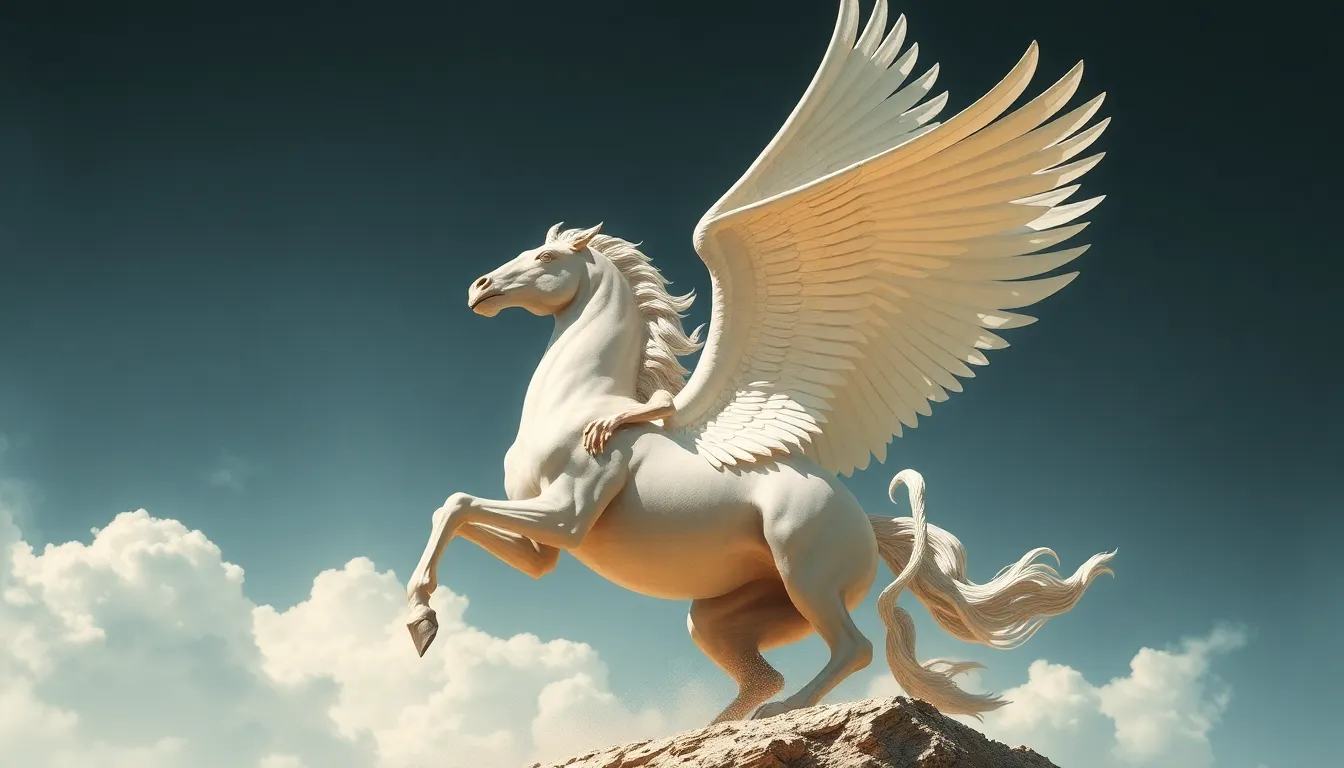Bellerophon and Pegasus: A Tale of Heroism and Hubris
I. Introduction
The myth of Bellerophon and Pegasus is a captivating tale woven into the fabric of Greek mythology, illustrating the dual themes of heroism and hubris. Bellerophon, a hero of extraordinary feats, rides the majestic winged horse, Pegasus, symbolizing both nobility and the heights of human aspiration. However, this tale also serves as a cautionary narrative about the dangers of excessive pride and ambition. In this article, we will explore these themes through the story of Bellerophon and his glorious yet tragic journey.
II. Historical Context of the Myth
The origins of the myth of Bellerophon can be traced back to ancient Greece, where stories were shared through oral tradition and later recorded by historians and poets. Bellerophon is often described in the works of authors such as Homer and Hesiod, who highlight his heroic qualities and divine lineage.
The influence of Bellerophon and Pegasus on Greek culture is profound. They have been depicted in various art forms, from pottery to sculptures, serving as a source of inspiration for generations. The myth embodies ideals of valor and the struggle between man and the divine, themes that resonate throughout Greek literature.
Variations of the myth exist across different sources. While the core narrative remains consistent, details often change, reflecting the cultural and regional nuances of the storytellers. These adaptations showcase the universality of the themes present in the story of Bellerophon and Pegasus.
III. Bellerophon: The Hero’s Journey
Bellerophon’s journey begins in Corinth, where he is born to the mortal king Glaucus and the daughter of the seer Polyidus. From an early age, Bellerophon displayed remarkable qualities, but his life takes a dramatic turn when he unintentionally kills his brother, prompting him to flee to the court of King Proetus of Argos.
The pivotal moment in Bellerophon’s life occurs when he is tasked with capturing Pegasus, the divine horse born from the blood of Medusa. This quest is not merely a test of strength but a demonstration of his worthiness as a hero. With the help of the goddess Athena, Bellerophon manages to tame Pegasus, marking the beginning of their legendary partnership.
Throughout his journey, Bellerophon faces numerous challenges, including:
- Defeating the raging Chimera, a fire-breathing monster.
- Overcoming the Solymi, a fierce tribe of warriors.
- Conquering the Amazons, legendary female fighters.
IV. Pegasus: The Winged Horse
Pegasus, the magnificent winged horse, is born from the blood of Medusa when she is slain by Perseus. This extraordinary creature embodies freedom, beauty, and the divine connection between the earthly and the celestial. In mythology, Pegasus is often associated with the Muses and the power of inspiration.
The bond between Bellerophon and Pegasus is one of mutual respect and trust. Their partnership allows Bellerophon to achieve feats that would be impossible alone. Together, they soar through the skies, symbolizing the heights of human potential and divine favor.
Pegasus serves as a representation of nobility and freedom, illustrating the ideal that true greatness is achieved through harmony with one’s gifts rather than through arrogance or domination.
V. The Triumphs of Bellerophon
With Pegasus at his side, Bellerophon accomplishes several major feats that solidify his status as a hero:
- He successfully slays the Chimera, a beast that terrorizes Lycia, showcasing his bravery and skill.
- He defeats the Solymi, proving his prowess in battle.
- He triumphs over the Amazons, further establishing his reputation as a formidable warrior.
Bellerophon’s triumph over the Chimera is particularly significant, as it not only brings him glory but also demonstrates the power of collaboration between man and the divine, represented by Pegasus. His deeds earn him widespread recognition, and he is celebrated as one of the greatest heroes of his time.
VI. The Downfall: Hubris and Its Consequences
In Greek mythology, hubris refers to excessive pride or self-confidence, often leading to a downfall. Bellerophon, after achieving great victories, begins to overreach his ambitions. He desires to ascend to Mount Olympus and be recognized among the gods, believing himself to be worthy of such honor.
This ambition leads him to attempt to fly to Olympus on Pegasus. However, Zeus, displeased by Bellerophon’s hubris, sends a gadfly to sting Pegasus. The startled horse throws Bellerophon off, leading to his tragic descent and subsequent isolation.
Bellerophon’s punishment serves as a stark reminder of the consequences of hubris. Once celebrated as a hero, he is left to wander alone, blind and broken, symbolizing the fall from grace that comes from overestimating one’s abilities and challenging the gods.
VII. Lessons from the Tale of Bellerophon and Pegasus
The tale of Bellerophon and Pegasus offers several important lessons:
- The balance between ambition and humility: While ambition can drive individuals to greatness, it is essential to remain grounded and recognize one’s limitations.
- A warning against overestimating one’s abilities: The story illustrates how hubris can lead even the greatest heroes to downfall.
- The enduring relevance of the tale: The themes of heroism and hubris resonate in contemporary society, reminding us of the importance of humility in our pursuits.
VIII. Conclusion
The myth of Bellerophon and Pegasus encapsulates key themes of heroism and hubris, illustrating the complex nature of human ambition. Bellerophon’s journey from a celebrated hero to a tragic figure serves as a poignant reminder of the fragility of success and the importance of humility.
As we reflect on the legacy of Bellerophon and Pegasus, we see their impact on modern culture, where their story continues to inspire art, literature, and moral lessons. The interplay of heroism and hubris remains a relevant aspect of the human experience, urging us to strive for greatness while remaining aware of the boundaries that define our existence.




